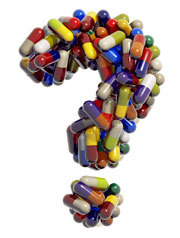Binning unused medication is kinder to the environment than returning it to the pharmacy, according to a new study. After considering the environmental implications of drug 'take-back' schemes - including greenhouse gas emissions from driving - researchers concluded such schemes offer no benefit over simply throwing or flushing the drugs away.
 |
| Drugs: to bin or to flush? That is the question. |
Studies on the environmental effects of drugs flushed into the sewers, such as contraceptives and antibiotics, have highlighted concerns about pharmaceutical waste. But what about the drugs we don't use? In the US, the White House recommends disposal with other household waste, to prevent safety hazards at home. However, Sweden has a long-running take-back programme and pilots for similar schemes are underway in the US.
Currently, around two thirds of unused drugs are binned in the US. Steven Skerlos' team at the University of Michigan wanted to know how switching to returning unused drugs would affect not only the levels of the pharmaceuticals found in the environment, but also carcinogenic, respiratory, climate and other emissions associated with their disposal. They based their estimates on the 10 most commonly returned drugs in the US, including paracetamol, aspirin and the steroid drug prednisone.
Assuming drugs were returned to pharmacies by driving and then incinerated before being sent to landfill, take-back schemes would eliminate all active pharmaceutical ingredient (API) emissions into the environment. But they would lead to massive increases in all other emissions - most notably, a dramatic 1700% rise in greenhouse gases, smog and ozone-depleting compounds. Even if take-back was only available in cities and half of drugs were returned on foot, other emissions would increase substantially. By comparison, binning all unused drugs would decrease API emissions from unused drugs by 88% - most being retained in landfill - whereas flushing would more than double API emissions, but in both cases other emissions would remain low.
On this evidence, it seems binning unused medication is the best option. But there are some potential game changers, says Skerlos. 'One is if a technology showed up at a wastewater treatment plant that could destroy the human excreted medication, as well as the unused medication,' he says. 'Then you just put the drugs in the toilet. And there is technology that can do that, it's just expensive.'
Michael Depledge, an environmental pollution expert and policy advisor at the Peninsula Medical School in Plymouth, US, disagrees with the recommendation to bin pharmaceuticals, but thinks the authors are missing the point. 'I think they're on the wrong course,' he says. 'It's incredibly important that we keep track of where pharmaceuticals are going, but the real issue is about people excreting them into the sewage system.'
Skerlos argues that we don't actually know whether unused drugs are a major source of pharmaceuticals entering the environment. At present, he says, there is not enough data to tell us what proportion comes from unused medication. Used and unused drugs should undergo similar chemical transformations as they enter the environment - from active forms, they can become conjugated either in the body or by wastewater treatment. However, according to co-author Nancy Love, there is limited information on the impact of some of these conjugated forms.
Another problem is that pharmaceuticals accumulate in local hotspots in the environment, says Depledge. This makes it difficult to compare the effects of local emissions to emissions like greenhouse gases, which contribute to environmental problems on a global scale.
Source: Royal Society of Chemistry
No comments:
Post a Comment